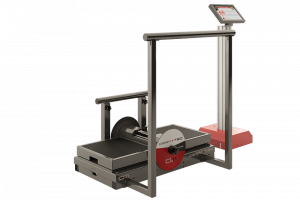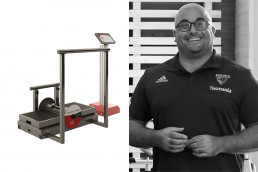Effects of in-season enhanced negative work-based vs traditional weight training on change of direction and hamstrings-to-quadriceps ratio in soccer players
Scientific features that investigates the effects of in-season enhanced negative work-based training (ENT) vs weight training in semi-professional soccer players, evaluated and measured through specific tests.
It was published by Dr. Giuseppe Coratella, researcher at the Università degli Studi in Milan, along with Prof. Marco Beato, Desmotec Academy member and Senior Lecturer in Strength & Conditioning at University of Suffolk, on Biol Sport, September 2019.
The study focuses on the different effects of in-season enhanced negative work-based training (ENT) and weight training in the change of direction (COD), sprinting and jumping ability, muscle mass and strength in semi-professional soccer players. The Desmotec device D.Full was also used in the research process.

Desmotec D.FULL
ABSTRACT
The present study investigated the effects of in-season enhanced negative work-based training (ENT) vs weight training in the change of direction (COD), sprinting and jumping ability, muscle mass and strength in semi-professional soccer players.
Forty male soccer players participated in the eight-week, 1 d/w intervention consisting of 48 squat repetitions for ENT using a flywheel device (inertia=0.11 kg·m-2) or weight training (80%1 RM) as a control group (CON). Agility T-test, 20+20 m shuttle, 10 m and 30 m sprint, squat jump (SJ) and countermovement jump (CMJ), lean mass, quadriceps and hamstrings strength and the hamstrings-to-quadriceps ratio were measured. Time on agility T-test and 20+20 m shuttle decreased in ENT (effect-size =-1.44, 95% CI -2.24/-0.68 and -0.75, -1.09/-0.42 respectively) but not in CON (-0.33, -0.87/0.19 and -0.13, -0.58/0.32). SJ and CMJ height increased in both ENT (0.71, 0.45/0.97 and 0.65, 0.38/0.93) and CON (0.41, 0.23/0.60 and 0.36, 0.12/0.70). Overall, quadriceps and hamstrings strength increased in both ENT and CON (0.38/0.79), but the hamstrings-to-quadriceps ratio increased in ENT (0.31, 0.22/0.40) but not in CON (0.03, -0.18/0.24). Lean mass increased in both ENT (0.41, 0.26/0.57) and CON (0.29, 0.14/0.44). The repeated negative actions performed in ENT may have led to improvements in braking ability, a key point in COD performance. Semi-professional soccer players may benefit from in-season ENT to enhance COD and the negative-specific adaptations in muscle strength and hamstrings-to-quadriceps ratio.
Click here to access the whole feature.

